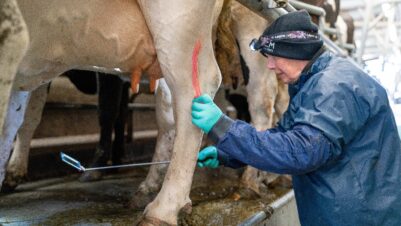Feline coronavirus (FCoV) is extremely virulent in the general cat population, especially in colonies and multi-cat households (Licitra and Whittaker, 2024). FCoV antibodies are present in up to 50 percent of felines in single-cat households and up to 90 percent of felines kept in large groups (ICC, 2024). This demonstrates the endemic nature of the FCoV pathogen.
Transmission occurs via the faecal-oral route, and theories suggest that the pathogen can survive in dried faeces for up to seven weeks. Often, no clinical signs are seen; however, FCoV can be associated with transient and self-limiting diarrhoea, to which kittens can be more susceptible (Licitra and Whittaker, 2024).
Some cases of FCoV infection develop into feline infectious peritonitis (FIP); studies suggest that around 5 percent of FCoV cases evolve into FIP (Licitra and Whittaker, 2024). Cats affected by FIP are generally under two years old; however, cases in older cats have been reported (Worthing et al., 2012). There is general agreement that genetic factors influence a cat’s susceptibility to FIP, with more pedigree cats seeming to be affected (Worthing et al., 2012).
Feline infectious peritonitis – an overview
Pathogenesis
FCoV replicates in the cells of the intestine and spreads systemically if not eliminated by the host. Two theories exist to explain why FCoV mutates into FIP: the circulating strain hypothesis and the spontaneous mutation hypothesis. The latter theory is the most widely accepted and suggests that each FIP case arises from a unique mutation of FCoV. The spontaneous mutation allows the virus to move its replication from the intestinal mucosa to the monocytes and macrophages in the body (Licitra and Whittaker, 2024).
The presence of the virus in the macrophages leads to the immune-mediated response characteristic of FIP. Overproduction of proinflammatory cytokines by the infected macrophages leads to the activation of systemic neutrophils, which causes granulomatous lesions to form (Licitra and Whittaker, 2024). These lesions can affect the central nervous system, eyes and intestines. Vasculitis leads to effusions developing; these occur most commonly in the abdomen, but pleural and even pericardial effusions have also been reported (Taylor et al., 2023).
Clinical signs of feline infectious peritonitis
FIP produces vague clinical signs such as lethargy, inappetence, weight loss (Figure 1) and persistent pyrexia. As granulomatous change can be seen anywhere in the body, the associated clinical signs can be varied.


We typically split cases of FIP into either a “wet” or “dry” category based on whether effusions are present. The development of effusions is dependent on the immune response of the patient (Licitra and Whittaker, 2024):
- Patients with a predominantly humoral immune response develop the protein-rich effusions we associate with “wet” FIP
- When cats have a mixed humoral and cell-mediated immune response, a non-effusive or “dry” FIP is seen
It is prudent to remember that FIP cases can display aspects of both “wet” and “dry” forms of the disease as each animal will have a different immune response to the virus.
Clinical pathology and diagnosis
Hyperglobulinaemia and hypoalbuminaemia, leading to a low albumin:globulin ratio, are often present in FIP patients. Liver and kidney values can also be elevated. Bilirubin elevations without evidence of haemolysis, primary liver disease or cholestasis are also commonly seen. Positive acute phase proteins, such as alpha-1 acid glycoproteins, are normally elevated. However, none of these changes are pathognomonic for FIP.

Fluid sampled from effusions is typically a straw-coloured (Figure 2), viscous and highly proteinaceous exudate (Licitra and Whittaker, 2024). FCoV reverse transcription polymerase chain reaction (RT-PCR) testing using effusion samples can be useful to strengthen diagnosis when the presence of high levels is demonstrated(Hartmann et al., 2003). Positive FCoV antibody titres of blood, cerebrospinal fluid or effusion samples are, unfortunately, not specific for the diagnosis of FIP. This is because most cats have been exposed to FCoV and have, therefore, developed antibodies (Licitra and Whittaker, 2024). Equally, 10 percent of cats with FIP can produce false-negative FCoV antibody titres (Hartmann et al., 2003).
Immunohistochemistry of tissue samples is the “gold standard” for confirming FCoV antigens in tissue macrophages. Although immunostaining cannot differentiate between non-pathogenic FCoV and FIP-causing FCoV, a positive result caused by large numbers of virus replication in the macrophages is highly indicative of FIP (Licitra and Whittaker, 2024).
Diagnosis of FIP is challenging and can only be confirmed post-mortem. Signalment and a collection of supporting clinical signs and clinical pathological findings are usually used to make a presumptive diagnosis.

Prognosis and treatment
Historically, the prognosis for cats suffering from FIP was very poor, with the presence of seizures considered a further negative prognostic indicator (Licitra and Whittaker, 2024). Until 2019, the treatment of FIP was based on the suppression of the host’s immune system and supportive care, such as fluid therapy, nutritional support and the centesis of effusions if warranted.
In the last five years, significant developments in the treatment of FIP have been made. Novel antiviral drugs are now available for use in the UK, including the nuclear analogues remdesivir and a remdesivir pro-drug, GS441524 (Pedersen et al., 2019; Taylor et al., 2024). Protocols for these drugs are constantly updated as more data becomes available, but currently, an 84-day course of GS441524 is recommended, with dosing that reflects the clinical signs (Taylor et al., 2024). When treating FIP with nucleoside analogues, an 85 percent survival rate has been noted (Taylor et al., 2023).
What is the nurse’s role in FIP treatment?
Cats with FIP often need intensive nursing and require extensive client support for their ongoing care. Nurses can lead client communications and recheck appointments under the supervision of a veterinary surgeon (VS). Ultimately, the success of treatment relies, in part, on an open channel of communication between the client and the practice; the registered veterinary nurse (RVN) is key to facilitating this.
Ultimately, the success of treatment relies, in part, on an open channel of communication between the client and the practice; the registered veterinary nurse is key to facilitating this
Nutrition
FIP patients can often present anorexic, so it’s important to encourage adequate nutrition as soon as possible. If the patient is unwilling to eat by mouth, the use of feeding tubes can be considered. Naso-gastric or naso-oesophageal tubes are generally favoured due to the ease of placement and maintenance. If long-term nutritional support is required, an oesophageal feeding tube can be placed and the owner taught to manage it at home.
Nurse consults
Current guidelines recommend repeating bloodwork at 2, 6 and 12 weeks after the commencement of GS441524 therapy (Taylor et al., 2024). As patients are usually young and still growing, it is crucial to weigh them regularly to ensure medications are dosed correctly.
Recheck consults can be largely nurse-led: the physical examination, point-of-care ultrasonography and history can be collected by an RVN and relayed to the VS for decision making. Again, this helps foster the relationship between the client and veterinary practice while using the skills of an RVN.
Limiting the spread of FIP
Unlike FCoV, FIP is thought to be largely non-transmissible; however, it is wise to isolate patients (Licitra and Whittaker, 2024). If this isn’t possible, they should be barrier-nursed appropriately to avoid the spread of FCoV. Full PPE should be donned when handling these patients. It is important to implement proper cleaning protocols in the clinic and at home as FCoV is readily inactivated by disinfectants (Licitra and Whittaker, 2024).
Client education and communication
It is vital that clients are educated on the pathogenesis of the disease to prevent reinfection and minimise the spread of FIP/FCoV in a multi-cat household. The management of households with FIP/FCoV infections includes the regular cleaning of litter boxes to lower the exposure to infected faeces.
It is vital that clients are educated on the pathogenesis of the disease to prevent reinfection and minimise the spread of FIP/FCoV in a multi-cat household
Owners should be aware that other cats in the household are likely to have been exposed to FCoV already, and a diagnosis in one cat is not a prediction of the development of FIP in other individuals. However, close monitoring for the development of any clinical signs is needed.
FCoV RT-PCR testing of faeces can help identify cats that are shedding and, therefore, have the potential to infect others. However, this comes with its own limitations, as the virus can be intermittently shed, and reinfection is common. Despite the low sensitivity of faecal RT-PCR testing, some breeders will use it to identify chronically shedding cats (Licitra and Whittaker, 2024).
Summary
The last five years have seen the treatment for FIP take giant leaps forward. Previously, feline infectious peritonitis had a 100 percent fatality rate, but with the use of novel treatments, we are now seeing survival rates of up to 85 percent. These cases are extremely rewarding to care for, with cats going on to live full lives after treatment ends.







